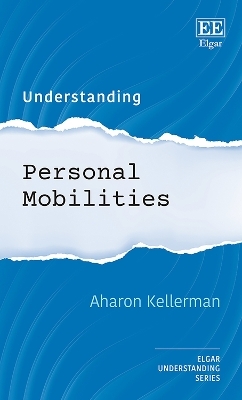
Understanding Personal Mobilities
Edward Elgar Publishing Ltd (Verlag)
978-1-0353-1394-5 (ISBN)
Kellerman begins with a presentation of the critical introductory concepts related to personal mobilities, including discussions of movement and travel, origins, path and destination, and the social value of personal freedom. He examines the nature of virtual space and its relationship with the physical, exploring conceptualizations of cyberspace, hybrid space, spatial media and Internet space. Chapters further highlight existing and new conceptual and theoretical knowledge for the understanding of self-driven mobilities, such as proximity, interaction, and distance; everyday mobilities; personal (im)mobilities; and Covid-19 and post-pandemic impacts on future trends for personal mobilities.
Expounding the basic human need for movement, this discerning book will prove an essential resource for students and scholars interested in mobilities across the disciplines of social geography, urban geography, sociology, transportation, and urban planning. Its interpretation of newly emerging practical realities for personal mobilities will also benefit transport and communications practitioners.
Aharon Kellerman, University of Haifa, Israel
Contents:
Preface xi
1 Introduction: personal mobilities and their contexts 1
1.1 The nature of personal mobilities 1
1.2 Characteristics of personal mobilities 2
1.3 Action spaces for personal mobilities 8
1.4 Personal autonomy in mobility 10
1.5 Summary 16
2 Motivations for routine physical personal mobilities 17
2.1 Introduction 17
2.2 Movement and travel 19
2.3 Movement motivations 21
2.4 Travel motivations 23
2.5 Designated motivations for frequent travel:
commuting and tourism 26
2.6 Mobility motivations and trip structures 27
2.7 Mobile persons and their motivations 28
2.8 Conclusion 29
3 Basic human requirements of physical and virtual spaces
and their implications 31
3.1 Introduction 31
3.2 Fixity 32
3.3 Mobility 33
3.4 Relationships between fixity and mobility 35
3.5 Fixity and mobility in virtual space 36
3.6 Leading implications of fixity and mobility 39
3.7 Basic human spatial requirements and human activities 39
3.8 The fixed and mobile humans 41
3.9 Fixity, mobility, and spatial entities 42
3.10 Interpretation of human spatial pulses 43
3.11 Conclusion 44
4 Proximity, interaction, and distance in physical and virtual
personal mobilities 46
4.1 Introduction 46
4.2 Contemporary interpretations for proximity, distance,
and space/location 48
4.3 The domination of distance and space: pre-Internet
social-spatial interaction 50
4.4 Internet and smartphone technologies: distance,
location, and space 52
4.5 The optionality of distance: the perspective of human choice 58
4.6 The preference for proximity 61
4.7 Proximity in individuals’ economic activities 62
4.8 Conclusion 63
5 Everyday carry of mobility items by individuals 66
5.1 Introduction 66
5.2 Everyday carry 68
5.3 Mobility-related EDC 69
5.4 Everydayness interpretations for mobility-related EDC items 74
5.5 Mobility interpretations for mobility-related EDC items 77
5.6 Conclusion 79
6 Personal (im)mobilities 81
6.1 Introduction 81
6.2 Fixity and immobility 82
6.3 Immobility and work 84
6.4 Travel and immobility 84
6.5 Other forms of immobility 86
6.6 Digital mobility and immobility 86
6.7 (Im)mobilities during COVID-19 lockdowns 87
6.8 Post-COVID-19 immobilities 89
6.9 Conclusion 92
7 Personal mobilities during and after the COVID-19 pandemic 94
7.1 Introduction 94
7.2 Functional and spatial expressions of pre-COVID-19
personal daily mobilities 97
7.3 Spatial expressions of personal periodical touristic mobilities 98
7.4 Daily and periodical personal mobilities during
COVID-19 times 98
7.5 New habit formations for personal mobilities during
COVID-19 times 100
7.6 Post-COVID-19 daily personal mobilities 102
7.7 Post-COVID-19 periodical personal touristic mobilities 104
7.8 Conclusion 105
8 Newly emerging personal mobility modes and the
post-COVID-19 city 108
8.1 Introduction 108
8.2 Electric and Internet-based mobilities in the 2020s 110
8.3 Comparative parameters for electrified and
Internetized road transport and communications 113
8.4 Individuals and the electrification and Internetization
of transport and communications 115
8.5 Electricity-based and Internet-dependent mobile society 117
8.6 Spatial and urban effects of mass adoption of EVs and AVs 118
8.7 Conclusion 120
9 Summaries and future perspectives 122
9.1 Book summary 122
9.2 Chapter summaries 124
9.3 Future personal mobilities and artificial text production 131
9.4 Future mobile persons 133
References 135
Index 151
| Erscheinungsdatum | 11.10.2023 |
|---|---|
| Reihe/Serie | Understanding series |
| Verlagsort | Cheltenham |
| Sprache | englisch |
| Maße | 156 x 234 mm |
| Themenwelt | Naturwissenschaften ► Geowissenschaften ► Geografie / Kartografie |
| Sozialwissenschaften ► Soziologie | |
| ISBN-10 | 1-0353-1394-4 / 1035313944 |
| ISBN-13 | 978-1-0353-1394-5 / 9781035313945 |
| Zustand | Neuware |
| Haben Sie eine Frage zum Produkt? |
aus dem Bereich


